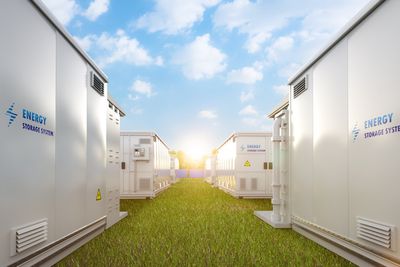by the numbers
Texas sees major increase in battery storage capacity, according to a new report

ERCOT will close 2023 with nearly 3.3 gigawatts of battery storage capacity and almost 10.7 gigawatts by the end of 2024. That would represent a one-year jump of 225 percent. Photo via Getty Images
The Electric Reliability Council of Texas — which runs the power grid serving about 90 percent of the state — is energizing the rise of U.S. battery storage capacity.
A new report from data provider S&P Global Commodity Insights forecasts that ERCOT will close 2023 with nearly 3.3 gigawatts of battery storage capacity and almost 10.7 gigawatts by the end of 2024. That would represent a one-year jump of 225 percent.
Austin-based ERCOT is expected to add nearly 400 megawatts of battery storage capacity during the third quarter after adding no capacity in the second quarter, according to S&P Global.
In terms of bulking up battery storage capacity, ERCOT had a momentous first quarter. The nonprofit organization added 498.6 megawatts of battery storage capacity during the first three months of 2023, accounting for 70.2 percent of all new capacity in the U.S., says S&P Global.
One gigawatt, which equals one billion watts, can provide enough power for about 750,000 homes.
ERCOT’s battery storage capacity has contributed to a lack of power outages during this year’s scorching summer heat in Texas. However, it’s worth noting that this summer’s wave of triple-digit temperatures is straining the ERCOT grid, prompting a series of pleas for Texans to conserve energy.
ERCOT set a new September peak demand record of 78,459 megawatts September 4, surpassing the previous September peak of 72,370 megawatts set on September 1, 2021. The current all-time peak demand, 85,435 megawatts, was set August 10.
As of September 5, ERCOT has set 10 records this year for peak demand. In 2022, ERCOT set 11 peak demand records, surpassing 80 gigawatts for the first time.
“Based on expected weather conditions, ERCOT anticipates there will be sufficient generation to meet customer demand this summer,” ERCOT said in its forecast for summertime power demand.
ERCOT’s combined solar and wind share of overall power generation is projected to reach 43 percent by 2035, according to S&P Global.
“Firing on all green energy cylinders, despite a long-surpassed renewable portfolio standard,” says S&P Global, “Texas leads the U.S. in operating and planned wind energy as well as solar and battery storage capacity in development … .”
Houston is playing a pivotal role in Texas’ adoption of battery storage of wind and solar power, with companies like Broad Reach Power and Key Capture Energy among the leaders.
“Known for its strong ties with oil and gas, Texas and Houston in particular are changing the narrative on their relationships with energy, with new innovations and initiatives being created to combat the effects of climate change and to create better, more efficient energy systems for years to come,” says the Greater Houston Partnership.
More than three-fourths of the 20.8 gigawatts of utility-scale battery storage capacity on track to be installed from 2022 to 2025 will be in Texas (7.9 gigawatts) and California (7.6 gigawatts), according to the U.S. Energy Information Administration.